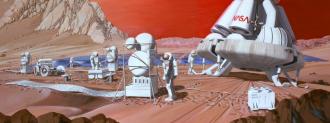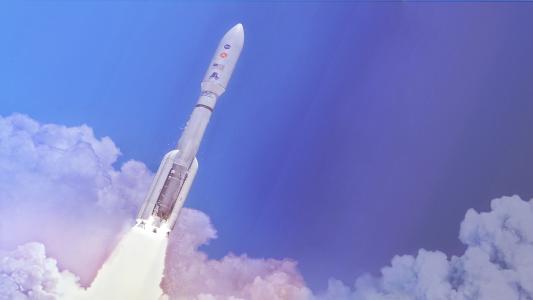This month, space agencies from the U.S., U.A.E, and China will send unmanned spacecraft to Mars. During the Mars mission, they will look for signs of past life on the red planet, and — if humanity is really to become a “multi-planetary” species — they’ll need to scout the area for future astronauts. With the prospect of a future Mars settlement, I can’t help but wonder, “Do I have what it takes to live on Mars?”
Some people know the answer to this question. For the past two decades, they have been going on simulated missions to Mars-like environments to learn the skills and strategies required for life in a small space and a hostile world. These “Mars analogs” are meant to mimic aspects of a real Mars mission — the physical and psychological environment.
A Mars Mission is a place where people go to learn about themselves.
Shannon Rupert
There are more than a dozen sites around the globe that have been used as a mock space station or to prepare astronauts for life on another planet. The missions help researchers develop and test the technology, procedures, and operations necessary for space exploration.
Shannon Rupert, director of the Mars Desert Research Station (MDRS) in Utah, says a Mars analog mission “is a place where people go to learn about themselves.”
The experience prepares the crew for a real Mars mission by training them to work and live in a Mars space station. But the lessons can apply to life on Earth.
I asked Rupert — and other Earth-bound galaxy travelers who spend significant time living and working in various purpose-built, Mars-like colonies — what essential skills they learned while living in a Mars analog.
Learning New Skills Begins With Self-Awareness
Rupert says that living in a Mars analog will teach you what you’re capable of. She learned early that she was “high strung,” which isn’t a desirable quality in a crewmate. But it was through a conscious effort that she learned the most crucial life skill: to be calm in the face of crisis. Rupert says that acquiring a talent like that begins with self-awareness.
“I’ve always been a quitter. If something doesn’t come fast to me, I let go of it. I just don’t try. Now I will methodically work through anything until I figure it out,” she says. “Part of that comes from knowing that you are the only person who can do it. There’s nobody there to save you on Mars.”
Focus on the Future
Julio Rezende founded Habitat Marte in 2017. The station is 62 mi west of Natal, Brazil where it only rains a few times a year — making the semi-arid region is a fair approximation to Mars.
Of the many missions Rezende completed, the biggest challenge wasn’t maintaining the greenhouse or collecting geological samples. The biggest challenge was loneliness.
Rezende likened his solo missions to how people who live alone might feel during the pandemic.
“It is important to have a vision of the future and small tasks to keep you moving toward that vision,” he says. “And that vision is a little bit related to hope too. And then it’s very important that we keep our emotions and our thoughts connected with this.”
Slow Down, Bond, and Savor
For the past decade, geologist James Karner has led the crew of the Antarctic Search for Meteorites (ANSMET). During December and January, eight people spend six weeks in a small camp, hunting for meteorites each day. Karner says that the habitat and confined quarters are like space travel.
Antarctic wind storms can blow as steady as 50-60 mph for days. When it is that bad, Karner says, the crew hunkers down inside their tents. With no access to social media, telephone, or texting, your tentmate becomes your family away from home. They spend the days talking, playing Yahtzee, or listening to diary readings — bonding moments for Karner.
At home, social media, the internet, and cell phones are replacing the face-to-face time Karner enjoyed as a child. Hence, he actually savors the chance to slow down and “just hang out.”
“I think you have that bond almost for life. I can see people that I went out in the field with 10 years before, and we instantly have that bond. And it’s on a personal level,” he says. “And you can be honest with them.”
The Human Spirit Is More Capable Than You Can Imagine
“They basically drop you off in the middle of nowhere, and you have to be safe and sound even in this harsh environment,” Karner says. “It’s a little daunting.”
Karner says the temperatures can typically be 15 below zero with 30 mph winds. Days and days of relentless chill brings on cold fatigue. Living and working outside every day teaches the crew small but essential habits — like how long they can remove their gloves before their fingers start to freeze. Most importantly, it shows them how capable they really are.
“When you’ve got your tent secure down, you’ve got enough food, you’ve got enough propane — it shows you the triumph of the human spirit. You can adapt, and you could live in these environments, even though they’re harsh and dangerous,” he says.
My Personal “Space Ship” Journey
The closest experience I’ve had to a Mars mission was my time spent sailing ocean passages. (Side note: I happened to name my current boat Rocinante, after the spacecraft in the song Cygnus X-1, Book I: The Voyage by Rush).
The ocean isn’t designed to support human life. Otherwise, we would all have gills. But the boat keeps me above water, and with some engineering, I can cook, generate electricity, carry enough drinking water, stay warm, and address most emergencies.
Rupert says that while preparing for a Mars mission, people often talk about the cumulative skill set of the crew: a well-rounded group has a doctor, engineer, etc. But they neglected to talk about the real skills that will serve them in any environment in the world or galaxy.
“We didn’t talk about all the other aspects until we started doing this research. And now people are like, ‘Oh, there’s a lot we have to discuss before we spend that much time together,” she says, adding that the best compliment someone could give her is to say they would go to Mars with her. But to earn that accolade from Rupert, one must be even-tempered, forthright, and laugh during difficult times.
“It isn’t going to be the technology. It’s not going to be the science. It’s going to be the people. How do we create an atmosphere where we can go there and be successful.”






